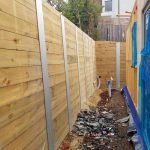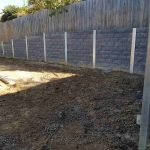Introduction
In the realm of building and construction and landscaping, keeping walls play an important role in managing soil disintegration, enhancing visual appeals, and providing structural assistance. However what goes into developing these vital structures? That's where the knowledge of knowledgeable keeping wall contractors comes into play. Whether you're looking for a retaining wall installer, a retaining wall contractor, or simply curious about the products utilized like concrete sleepers, H beams, wood sleepers, timber sleepers, or stone, understanding their engineering understanding is vital.
Understanding the Engineering Knowledge of Experienced Retaining Wall Builders
The procedure of building a keeping wall is more than just stacking blocks or putting concrete. It involves a deep understanding of soil mechanics, hydrology, and structural engineering principles. Proficient maintaining wall builders have not simply experience however also a variety of technical skills that allow them to navigate the complexities involved in this kind of construction.
When you consider it, every project provides special obstacles. The site conditions can differ commonly-- ranging from steep slopes to loose soils-- and this irregularity requires customized solutions. A competent retaining wall builder evaluates these factors carefully to pick the best style and materials. For example, when dealing with extensive clay soils that broaden and contract based on moisture levels, particular strategies need to be used to avoid failure.
What Makes Keeping Walls Essential?
Retaining walls are basic for numerous reasons:
Soil Disintegration Control: They help stabilize slopes and avoid soil displacement. Creating Usable Land: By leveling land, they broaden functional space for gardens or patios. Aesthetic Appeal: Beautifully designed walls can enhance property value. Water Management: They can direct water stream away from structures.These elements illustrate why hiring an experienced expert is critical for guaranteeing durability and functionality.
Types of Maintaining Walls
Gravity Walls
- These depend on their weight to keep back soil. Typically made from concrete or stone.
Cantilevered Walls
- Utilize a lever arm created to withstand lateral pressure. Often constructed using strengthened concrete.
Anchored Walls
- Use cables anchored in the earth behind the wall. Highly efficient for high-pressure situations.
Modular Block Walls
- Made from interlocking blocks held together by gravity. Easy to set up and maintain.
Sheet Pile Walls
- Consist of thin sections driven into the ground. Commonly used in soft soil conditions.
Materials Utilized in Retaining Wall Construction
Concrete Sleepers
Concrete sleepers are robust materials that provide sturdiness and versatility in design. They're particularly effective for modern-day aesthetic preferences while needing very little maintenance over time.
H Beams
H beams provide significant strength for taller walls where there's considerable lateral pressure from soil. Their http://brooksunny233.huicopper.com/employing-a-retaining-wall-installer-what-you-required-to-know industrial style frequently provides itself well to contemporary landscapes.
Wood Sleepers & Lumber Sleepers
Wood-based options provide an eco-friendly alternative but require careful treatment against rot and insects. Timber uses natural beauty but might demand regular upkeep to make sure longevity.
Stone Retaining Walls
Stone walls stimulate a sense of timelessness and can blend perfectly with natural landscapes. Nevertheless, they typically require greater labor costs due to their intricate installation processes.
The Function of Soil Mechanics in Structure Retaining Walls
Understanding soil habits is basic for any retaining wall builder. Soil types vary extensively-- sand drains rapidly while clay maintains wetness-- and each type has various load-bearing capabilities that impact how a wall will perform over time.
Why Do Various Soils Matter?
Clay soils can swell when wet, increasing pressure against walls. Sandy soils might move unexpectedly without proper drain systems in place. Rocky surfaces may need specialized devices for excavation or anchoring.An experienced specialist will carry out extensive site examinations, including soil tests, before picking specs for materials and designs.
Hydrology Concerns in Retaining Wall Design
Water management straight influences stability; pooling water behind a wall develops hydrostatic pressure that can lead to devastating failures if not appropriately managed through drainage services like weep holes or French drains.
How Do Drain Systems Work?
Weep holes allow excess water to escape. French drains redirect water flow far from walls. Proper grading keeps water far from susceptible areas.Ignoring these aspects could result in costly repairs down the line!
Cost Factors to consider When Employing a Retaining Wall Builder
Building a keeping wall isn't practically selecting materials; it's likewise about budgeting efficiently for both immediate costs and long-lasting upkeep costs related to various kinds of walls.
|Type|Average Expense (per foot)|Durability|Maintenance Level|| --------------------|-------------------------|------------|-------------------|| Concrete Sleepers|$20 - $30|50+ years|Low|| H Beams|$25 - $35|40+ years|Medium|| Wood Sleepers|$15 - $25|15 - 30 years|High|| Stone|$30 - $50|100+ years|Low|
Investing sensibly guarantees resilience without breaking the bank!
FAQ Section
What credentials ought to I search for in a retaining wall contractor?
Look for certifications related to construction management, as well as experience particular to keeping walls-- a portfolio showcasing previous tasks helps too!
How do I determine which material is best for my project?
Consider factors such as place (soil type), preferred visual appeals, spending plan restraints, and whether you prefer low-maintenance options over visual appeal.
What's involved in getting permits for building maintaining walls?
Local regulations vary; generally, you'll need strategies submitted by your contractor showing compliance with zoning laws before approval is provided by city coordinators or other authorities.

Can I build my own keeping wall?
While do it yourself projects are possible, they require substantial knowledge about local soils & & hydrology as well as engineering concepts; mistakes can cause pricey repair work later on on!
How long does it take to build a retaining wall?
Depending on intricacy & & size-- expect anywhere from one weekend (for small modular jobs) up to numerous weeks (for bigger custom builds).
Are there any ecological factors to consider when constructing a maintaining wall?
Absolutely! Always guarantee your task adheres to regional guidelines regarding wildlife habitats & & run-off control measures throughout building activities!

Conclusion
In summary, comprehending the engineering proficiency of knowledgeable keeping wall builders is essential whether you're planning your next home enhancement project or just want more insight into landscaping techniques that protect your home investment! From acknowledging numerous types of products-- like concrete sleepers or stone-- to understanding hydrological effects and cost considerations-- everything come down to making informed decisions backed by professional understanding! So don't think twice; seek advice from professionals who bring years of experience in addition to ingenious options customized specifically towards attaining lasting results!